IEEE-488 Reference
3-6
turns on. When the instrument is in remote, all front panel
keys except for the LOCAL key are locked out. When REM
is turned off, the instrument is in the local state, and front
panel operation is restored.
TALK —
This indicator is on when the instrument is in the
talker active state. The unit is placed in this state by address-
ing it to talk with the correct MTA (My Talk Address) com-
mand. TALK is off when the unit is in the talker idle state.
The instrument is placed in the talker idle state by sending it
an UNT (Untalk) command, addressing it to listen, or with
the IFC (Interface Clear) command.
LSTN —
This indicator is on when the Model 2002 is in the
listener active state, which is activated by addressing the in-
strument to listen with the correct MLA (My Listen Address)
command. Listen is off when the unit is in the listener idle
state. The unit can be placed in the listener idle state by send-
ing UNL (Unlisten), addressing it to talk, or by sending IFC
(Interface Clear) over the bus.
SRQ —
The instrument can be programmed to generate a
service request (SRQ) when one or more errors or conditions
occur. When this indicator is on, a service request has been
generated. This indicator will stay on until the serial poll byte
is read or all the conditions which caused SRQ have ceased
to exist. See paragraph 3.7.6 for details.
3.6.3 LOCAL key
The LOCAL key cancels the remote state and restores local
operation of the instrument.
Pressing LOCAL also turns off the REM indicator and
returns the display to normal if a user defined message was
displayed.
Note that the LOCAL key is also inoperative if the LLO
(Local Lockout) command is in effect.
3.7 Status structure
The status structure for the Model 2002 is summarized in
Figure 3-4. Instrument events, such as errors, are monitored
and manipulated by seven status register sets. Notice that
these seven status register sets feed directly or indirectly into
the Status Byte Register. More detailed illustrations of these
register sets are provided by Figures 3-5 through 3-11.

